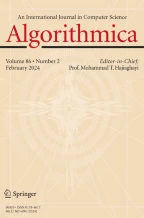Abstract
We consider the on-line version of the maximum vertex disjoint path problem when the underlying network is a tree. In this problem, a sequence of requests arrives in an on-line fashion, where every request is a path in the tree. The on-line algorithm may accept a request only if it does not share a vertex with a previously accepted request. The goal is to maximize the number of accepted requests. It is known that no on-line algorithm can have a competitive ratio better than Ω(log n) for this problem, even if the algorithm is randomized and the tree is simply a line. Obviously, it is desirable to beat the logarithmic lower bound. Adler and Azar (Proc. of the 10th ACM-SIAM Symposium on Discrete Algorithm, pp. 1–10, 1999) showed that if preemption is allowed (namely, previously accepted requests may be discarded, but once a request is discarded it can no longer be accepted), then there is a randomized on-line algorithm that achieves constant competitive ratio on the line. In the current work we present a randomized on-line algorithm with preemption that has constant competitive ratio on any tree. Our results carry over to the related problem of maximizing the number of accepted paths subject to a capacity constraint on vertices (in the disjoint path problem this capacity is 1). Moreover, if the available capacity is at least 4, randomization is not needed and our on-line algorithm becomes deterministic.
Similar content being viewed by others
References
Adler, R., Azar, Y.: Beating the logarithmic lower bound: randomized preemptive disjoint paths and call control algorithms. In: Proc. of the 10th ACM-SIAM Symposium on Discrete Algorithms, pp. 1–10 (1999)
Alon, N., Arad, U., Azar, Y.: Independent sets in hypergraphs with applications to routing via fixed paths. In: Proc. 2nd Workshop on Approximation Algorithms for Combinatorial Optimization Problems (APPROX), pp. 16–27 (1999)
Andrews, M., Chuzhoy, J., Khanna, S., Zhang, L.: Hardness of the undirected edge-disjoint paths problem with congestion. In: Proceedings 46th Annual IEEE Symposium on Foundations of Computer Science, pp. 226–244 (2005)
Aspnes, J., Azar, Y., Fiat, A., Plotkin, S., Waarts, O.: On-line routing of virtual circuits with applications to load balancing and machine scheduling. J. ACM 44(3), 486–504 (1997). Also in Proc. 25th ACM STOC, 1993, pp. 623–631
Awerbuch, B., Azar, Y., Plotkin, S.: Throughput-competitive online routing. In: 34th IEEE Symposium on Foundations of Computer Science, pp. 32–40 (1993)
Awerbuch, B., Bartal, Y., Fiat, A., Rosén, A.: Competitive non-preemptive call control. In: Proc. of 5th ACM-SIAM Symposium on Discrete Algorithms, pp. 312–320 (1994)
Awerbuch, B., Gawlick, R., Leighton, T., Rabani, Y.: On-line admission control and circuit routing for high performance computation and communication. In: Proc. 35th IEEE Symp. on Found. of Comp. Science, pp. 412–423 (1994)
Awerbuch, B., Azar, Y., Fiat, A., Leonardi, S., Rosen, A.: On-line competitive algorithms for call admission in optical networks. In: Proc. 4th Annual European Symposium on Algorithms, pp. 431–444 (1996)
Bartal, Y., Fiat, A., Leonardi, S.: Lower bounds for on-line graph problems with application to on-line circuit and optical routing. In: Proc. 28th ACM Symp. on Theory of Computing, pp. 531–540 (1996)
Borodin, A., El-Yaniv, R.: Online Computation and Competitive Analysis. Cambridge University Press, Cambridge (1998)
Cormen, T.T., Leiserson, C.E., Rivest, R.L.: Introduction to Algorithms. MIT Press, Cambridge (1990)
Garay, J., Gopal, I., Kutten, S., Mansour, Y., Yung, M.: Efficient on-line call control algorithms. J. Algorithms 23, 180–194 (1997). Also in Proc. 2nd Annual Israel Conference on Theory of Computing and Systems (1993)
Garg, N., Vazirani, V.V., Yannakakis, M.: Primal-dual approximation algorithms for integral flow and multicut in trees. In: ALGORITHMICA, vol. 18, pp. 3–20 (1997)
Kleinberg, J., Tardos, E.: Disjoint paths in densely embedded graphs. In: Proc. 36th IEEE Symp. on Found. of Comp. Science, pp. 52–61 (1995)
Leonardi, S.: On-line network routing. In: Fiat, A., Woeginger, G. (eds.) Online Algorithms—The State of the Art, pp. 242–267. Springer, Berlin (1998). Chap. 11
Leonardi, S., Marchetti-Spaccamela, A., Presciutti, A., Rosén, A.: On-line randomized call control revisited. In: Proc. 9th ACM-SIAM Symp. on Discrete Algorithms, pp. 323–332 (1998)
Lipton, R.J., Tomkins, A.: Online interval scheduling. In: Proc. of the 5th ACM-SIAM Symposium on Discrete Algorithms, pp. 302–311 (1994)
Raghavan, P., Thompson, C.D.: Randomized rounding: a technique for provably good algorithms and algorithmic proofs. Combinatorica 7(4), 365–374 (1987)
Author information
Authors and Affiliations
Corresponding author
Additional information
Research supported in part by the Israel Science Foundation.
Rights and permissions
About this article
Cite this article
Azar, Y., Feige, U. & Glasner, D. A Preemptive Algorithm for Maximizing Disjoint Paths on Trees. Algorithmica 57, 517–537 (2010). https://doi.org/10.1007/s00453-009-9305-4
Received:
Accepted:
Published:
Issue Date:
DOI: https://doi.org/10.1007/s00453-009-9305-4
